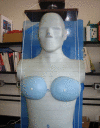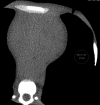Radiation dose from single-heartbeat coronary CT angiography performed with a 320-detector row volume scanner
- PMID: 20177085
- PMCID: PMC2826696
- DOI: 10.1148/radiol.09090779
Radiation dose from single-heartbeat coronary CT angiography performed with a 320-detector row volume scanner
Abstract
Purpose: To determine radiation doses from coronary computed tomographic (CT) angiography performed by using a 320-detector row volume scanner and evaluate how the effective dose depends on scan mode and the calculation method used.
Materials and methods: Radiation doses from coronary CT angiography performed by using a volume scanner were determined by using metal-oxide-semiconductor field-effect transistor detectors positioned in an anthropomorphic phantom physically and radiographically simulating a male or female human. Organ and effective doses were determined for six scan modes, including both 64-row helical and 280-row volume scans. Effective doses were compared with estimates based on the method most commonly used in clinical literature: multiplying dose-length product (DLP) by a general conversion coefficient (0.017 or 0.014 mSv.mGy(-1).cm(-1)), determined from Monte Carlo simulations of chest CT by using single-section scanners and previous tissue-weighting factors.
Results: Effective dose was reduced by up to 91% with volume scanning relative to helical scanning, with similar image noise. Effective dose, determined by using International Commission on Radiological Protection publication 103 tissue-weighting factors, was 8.2 mSv, using volume scanning with exposure permitting a wide reconstruction window, 5.8 mSv with optimized exposure and 4.4 mSv for optimized 100-kVp scanning. Estimating effective dose with a chest conversion coefficient resulted in a dose as low as 1.8 mSv, substantially underestimating effective dose for both volume and helical coronary CT angiography.
Conclusion: Volume scanning markedly decreases coronary CT angiography radiation doses compared with those at helical scanning. When conversion coefficients are used to estimate effective dose from DLP, they should be appropriate for the scanner and scan mode used and reflect current tissue-weighting factors. (c) RSNA, 2010.
Figures









References
-
- Stein PD, Yaekoub AY, Matta F, Sostman HD. 64-slice CT for diagnosis of coronary artery disease: a systematic review. Am J Med 2008;121:715–725 - PubMed
-
- National Council on Radiation Protection and Measurements Ionizing radiation exposure of the population of the United States. Report no. 160. Bethesda, Md: National Council on Radiation Protection and Measurements, 2009
-
- Einstein AJ, Henzlova MJ, Rajagopalan S. Estimating risk of cancer associated with radiation exposure from 64-slice computed tomography coronary angiography. JAMA 2007;298:317–323 - PubMed
-
- Raff GL, Chinnaiyan KM, Share DA, et al. Radiation dose from cardiac computed tomography before and after implementation of radiation dose-reduction techniques. JAMA 2009;301:2340–2348 - PubMed
-
- Shuman WP, Branch KR, May JM, et al. Prospective versus retrospective ECG gating for 64-detector CT of the coronary arteries: comparison of image quality and patient radiation dose. Radiology 2008;248:431–437 - PubMed
Publication types
MeSH terms
Grants and funding
LinkOut - more resources
Full Text Sources

